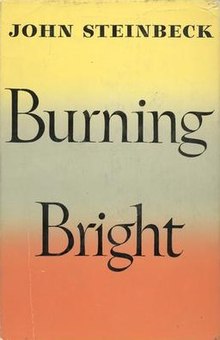Burning Bright

First edition cover
|
|
| Author | John Steinbeck |
|---|---|
| Country | United States |
| Language | English |
| Publisher | The Viking Press |
|
Publication date
|
1950 |
| Media type | Print (Hardback & Paperback) |
| Pages | 93 pp |
Burning Bright is a 1950 novella by John Steinbeck written as an experiment with producing a play in novel format. Rather than providing only the dialogue and brief stage directions as would be expected in a play, Steinbeck fleshes out the scenes with details of both the characters and the environment. The intention was to allow the play to be read by the non-theatrical reader while still allowing the dialogue to be lifted and performed with little adaptation by acting companies. While Steinbeck could see that providing little information in the way of physical description or stage direction allowed the director and actors greater freedom and scope for imaginative interpretation, he weighed this against the benefit of making the players aware of the author's intent and making the play accessible to the general reader.
The story is a simple morality play concerning Joe Saul, an aging man desperate for a child. His young wife, Mordeen, who loves him, suspects that he is sterile, and in order to please him by bearing him a child, she becomes pregnant by Saul's cocky young assistant, Victor. The fourth character in the story is Friend Ed, a long-time friend of Saul and Mordeen, who helps the couple through the ordeal after Joe discovers that he is indeed infertile and the child can not be his. The story is meant to be that of an everyman (early in its development Steinbeck had thought of calling the play Everyman), so the setting for each of the three acts recasts the four characters in different situations: the first act is set in a circus, Saul and Victor are trapeze artists and Friend Ed, a clown; in the second act, Saul and Friend Ed become neighbouring farmers and Victor appears as Saul's farmhand. In the final act Saul is the captain of a ship, Mr. Victor, his mate, and Friend Ed a seaman about to put out on a different ship. Act three is divided into two scenes; the final scene is set in a hospital where the child is delivered; it makes no reference to any of the settings of the three acts, and so serves equally as a conclusion for any of the stories.
Burning Bright was Steinbeck's third attempt at writing what he called a "play-novelette". He had tried something similar with Of Mice and Men in 1937 and The Moon Is Down in 1942, but, of the three, Burning Bright was the most complete attempt at the form. Steinbeck believed that he may have been the first person to attempt the style. At the time of writing the introduction, in which he explained his intentions, he believed it was a form that would bear further experimentation. In a continuation of the experiment, a stage production was planned to open at the same time the book was published. The original title of the book, In the Forests of the Night, was a line from The Tyger by William Blake, but complaints that it was too long and too literary by the producers of the play led to the change to the shorter excerpt from the same poem: Burning Bright.
...
Wikipedia
